
Cheddar cheese is a natural cheese that is relatively hard, off-white, and sometimes sharp-tasting. It originates from the English village of Cheddar in Somerset, South West England.

Gruyère is a hard Swiss cheese that originated in the cantons of Fribourg, Vaud, Neuchâtel, Jura, and Berne in Switzerland. It is named after the town of Gruyères in Fribourg. In 2001, Gruyère gained the appellation d'origine contrôlée (AOC), which became the appellation d'origine protégée (AOP) as of 2013.
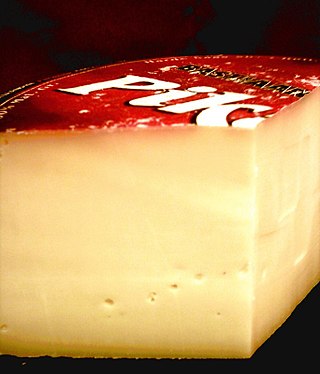
Gouda cheese is a creamy, yellow cow's milk cheese originating from the Netherlands. It is one of the most popular and produced cheeses worldwide. The name is used today as a general term for numerous similar cheeses produced in the traditional Dutch manner.

Brie is a soft cow's-milk cheese named after Brie, the French region from which it originated. It is pale in colour with a slight greyish tinge under a rind of white mould. The rind is typically eaten, with its flavour depending largely upon the ingredients used and its manufacturing environment. It is similar to Camembert, which is native to a different region of France. Brie typically contains between 60% and 75% butterfat, slightly higher than Camembert.

Halloumi or haloumi is a cheese that originated in Cyprus. It is made from a mixture of goat's and sheep's milk, and sometimes also cow's milk. Its texture is described as squeaky. It has a high melting point and so can easily be fried or grilled, a property that makes it a popular meat substitute. Rennet is used to curdle the milk in halloumi production, although no acid-producing bacteria are used in its preparation.

Caerphilly is a hard, crumbly white cheese that originated in the area around the town of Caerphilly, Wales. It is thought to have been created to provide food for the local coal miners. The Caerphilly of that period had a greater moisture content, and was made in local farms. At the start of the 20th century, competition for milk in the local area saw production decline, and Caerphilly production was gradually relocated to England.

Red Leicester is an English cheese similar to Cheddar cheese, but crumbly in texture. It is typically aged 6 to 12 months. The rind is reddish-orange with a powdery mould on it. Since the 18th century, it has been coloured orange by the addition of annatto extract during manufacture. It is a cow's milk cheese, and is named after the city of Leicester, or the ceremonial county it is located in, Leicestershire.

Goat cheese, goat's cheese or chèvre is cheese made from goat's milk. Goats were among the first animals to be domesticated for producing food. Goat cheese is made around the world with a variety of recipes, giving many different styles of cheeses, from fresh and soft to aged and hard.
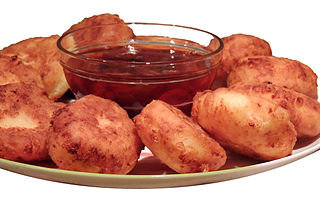
Syrniki or syrnyky are fried Eastern Slavic quark pancakes. They are a part of Belarusian, Russian, Ukrainian, Latvian and Lithuanian cuisine (varškėčiai). In Russia, they are also known as tvorozhniki (творо́жники).

Camembert is a moist, soft, creamy, surface-ripened cow's milk cheese. It was first made in the late 18th century in Camembert, Normandy, in northwest France. It is sometimes compared in look, taste and texture to brie cheese, albeit with a slightly lower butterfat content than brie's typical 20% – 25% by weight.

Ricotta is an Italian whey cheese made from sheep, cow, goat, or Italian water buffalo milk whey left over from the production of other cheeses. Like other whey cheeses, it is made by coagulating the proteins that remain after the casein has been used to make cheese, notably albumin and globulin.

An Eccles cake is a small, round pie, similar to a turnover, filled with currants and made from flaky pastry with butter, sometimes topped with brown sugar.
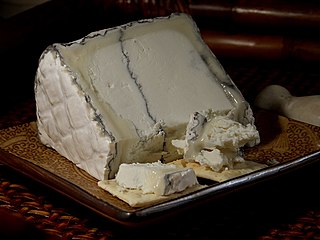
Humboldt Fog is a goat milk cheese made by Cypress Grove, of Arcata, California, in Humboldt County. It is named for the local ocean fog which rolls in from Humboldt Bay. It is an uncooked pressed cheese made from pasteurized goat's milk.
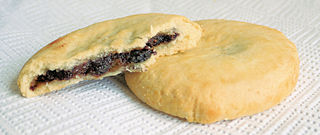
Chorley cakes are flattened, fruit filled pastry cakes, traditionally associated with the town of Chorley in Lancashire, England.

Cotija is an aged Mexican cheese made from cow's milk and named after the town of Cotija, Michoacán. White in color and firm in texture, its flavor is salty and milky. "Young" cotija cheese has been described as akin to a mild feta, while aged (añejo) cotija is more comparable in flavor to hard, aged cheeses like Parmesan. Cotija softens when exposed to heat, but does not melt. Made between the summer and fall seasons, this cheese is made with milk from local cattle and is salted before the fermentation process. The manufacturing processes of most cheeses in Mexico are still rustic and traditional, similar to the manufacturing process that was used upon its invention. Due to the traditional means of production of dairy products in Mexico some dairy products have a conflicting shelf-life which leads to earlier expiration. However, some studies suggest components in the fermentation of Cotija Cheese are natural preservatives that can extend the shelf-life of Cotija Cheese and other food products as well.

Caprino is an Italian cheese traditionally made from whole or skimmed goat's milk. The name of the cheese derives from the Italian word for goat, capra. With modern methods of production, the cheese is made from cow's milk as well or a combination of both cow's and goat's milks. The two major styles of caprino are fresco ("fresh") and stagionato ("aged").

Cornish Yarg is a semi-hard cow's milk cheese made in Cornwall, England. Before being left to mature, the cheese is wrapped in nettle leaves to form an edible, though mouldy, rind. The texture varies from creamy and soft immediately under the nettle coating to a Caerphilly cheese-like crumbly texture in the middle.
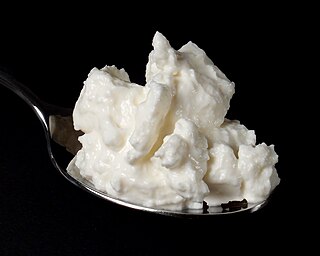
Quark or quarg is a type of fresh dairy product made from milk. The milk is soured, usually by adding lactic acid bacteria cultures, and strained once the desired curdling is achieved. It can be classified as fresh acid-set cheese. Traditional quark can be made without rennet, but in modern dairies small quantities of rennet are typically added. It is soft, white and unaged, and usually has no salt added.



















